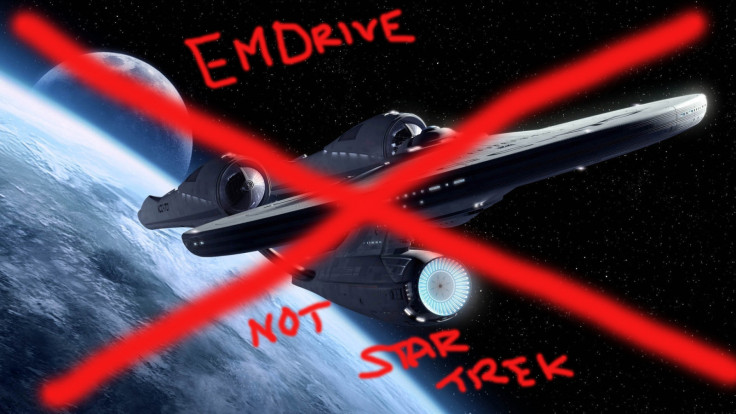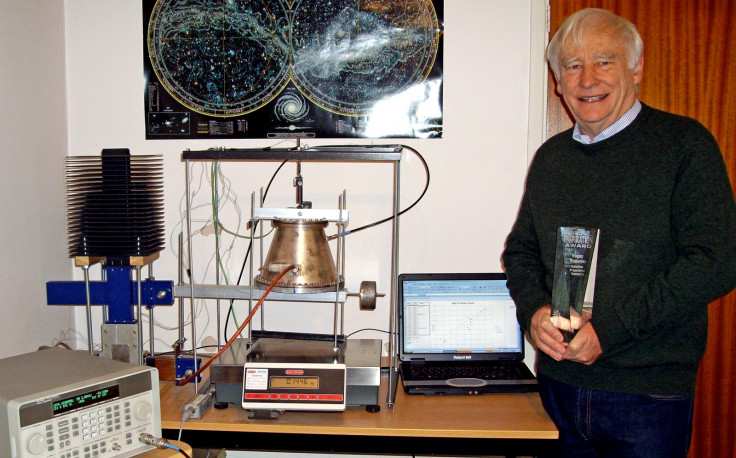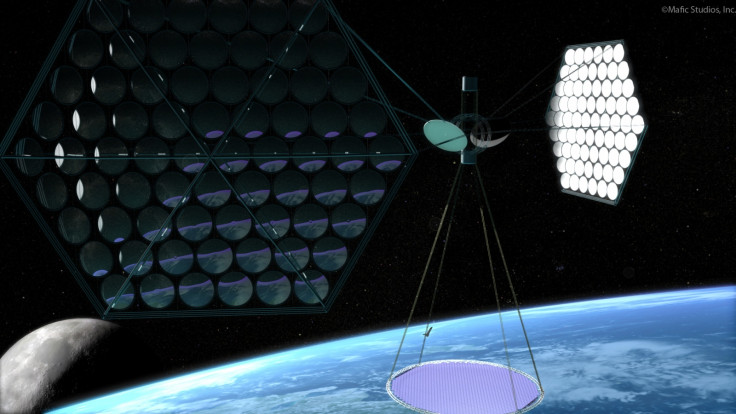EmDrive and 'warp drive' are two different things - Nasa's still working on EmDrive

Nasa has confirmed that it's definitely not working on warp drive technology, but if you look carefully, they haven't said anything about EmDrive, which is where the real story is.
"While conceptual research into novel propulsion methods by a team at Nasa's Johnson Space Center in Houston has created headlines, this is a small effort that has not yet shown any tangible results," Nasa officials told Space.com. "Nasa is not working on warp drive technology."
On 29 April, Nasa scientists wrote an article on Nasa Spaceflight that they had tested British scientist Roger Shawyer's controversial electromagnetic space propulsion technology called EmDrive and were unable to disprove their results, indicating that the technology worked.
However forum users looking at the experiment results also found that when lasers were fired into the EmDrive's resonance chamber, some of the laser beams had travelled faster than the speed of light, which would mean the EmDrive could have produced a warp bubble, also known as a warp drive.
The problem is that some media vehicles, such as Mashable, The Independent, Forbes and NBC who didn't understand what EmDrive is, began equating it with this "warp drive" sci-fi concept, and now that Nasa says it doesn't work, ergo that means EmDrive doesn't work.
Following Nasa's denial that it was working on a warp drive, on 14 May Shawyer was interviewed by the Daily Mail, for a story which claimed he invented Star Trek's warp speed. The scientist has told IBTimes UK he has been completely misrepresented.
"Actually what happened is the guys at Eagleworks at Nasa did an experiment where they shot a laser through a cavity. They just focused on EmDrive, but the problem is, Eagleworks focuses on advanced propulsion, and they did mention the warp drive concept before at some point," Shawyer said.
"It's all nonsense, and NASA's right to try to suppress this. I told the Daily Mail you could get to the moon in four hours with EmDrive, but it's not warping there in less than a second, it's using quantum mechanics.
"The one link between these exotic physics concepts like warp drive and quantum vacuum plasma, which go against mainstream physics, is that they rely on Einstein's theory of general relativity.
"General relativity is all about space/time and is the next step on from special relativity, but I don't need to go any further than special relativity for EmDrive."
Why EmDrive and 'Warp Drive' are two completely different things

IBTimes UK has been covering EmDrive since August 2014, when we interviewed Shawyer about the technology.
EmDrive is based on the theory of special relativity that it is possible to convert electrical energy into thrust without the need to expel any form of repellent.
Shawyer's critics say according to the law of conservation of momentum, his theory cannot work as in order for a thruster to be propelled forwards, something must be pushed out of the back of it in the opposite direction.
However, EmDrive does preserve the conservation of momentum and energy – to put it simply, electricity converts into microwaves within the cavity that push against the inside of the device, causing the thruster to accelerate in the opposite direction.
Shawyer proved that if you had a 100kg spacecraft, the thrust would be in a clockwise direction and the spacecraft would then accelerate in an anti-clockwise direction.
On the other hand, a warp drive apparently enables space propulsion that is faster than the speed of light. It's a concept that was invented by the makers of Star Trek, together with a whole host of other cool, futuristic-sounding, psuedo-science terms that all don't make any sense and have no basis in reality.
According to Memory Alpha, the Star Trek Wiki, which references a 1967 Star Trek scriptwriters' guide issued by the TV production company:
The use of the term "hyperdrive" in "The Cage" was never fully explained, but the writer's guide, The Star Trek Guide (third revision, page 8) [1] suggests an origin for the term. According to the guide, "hyper-light speed" was an alternative, less preferred, term for "space warp speed". Hyperdrive later became more prominently known as the ftl drive in the Star Wars franchise.
Where in any of Shawyer's research or any research on the internet on EmDrive has it ever been alleged that EmDrive is faster than the speed of light?
There's no "faster than the speed of light" in EmDrive
Shawyer told IBTimes UK in August 2014: "The space industry doesn't want to know about it as it's very disruptive. If the customer will spend hundreds of millions of dollars on launching a satellite, why would you want to make something that could do it cheaper?
"This technology is a quantum leap – it would enable vertical take-off and landing for airplanes, it's quiet and it uses liquid hydrogen as a fuel, so it's green too."
EmDrive is merely a technology that would make vertical take-offs possible and potentially greatly bring down the cost of sending satellites into space – this alone would be an aerospace revolution, without any "sci-fi" speed of light nonsense thrown into it.
EmDrive is still coming, whether you believe it or not

But even if people don't believe that EmDrive works, Shawyer told us in a recent interview about the Nasa experiment that it really doesn't matter, because many private companies are working on the technology.
"There are a number of very important organisations now working on second generation EmDrive, both partnering with us and competing against us. Most of the real work is done by private companies, so they don't have a need to publicise it," he said.
"You need to think about which countries who don't have a vested interest in the aerospace long-haul aircraft industries – they will not be the Boeings and the Airbuses, but some of the developing nations."
According to Shawyer, the technology would make it possible to use satellites to not only solve the energy crisis, but also mitigate the effects of climate change.
"We will go to Mars, but the most important thing is what EmDrive will do for the rest of the world. It will be solar power stations, city-to-city long-haul flights using hydrogen. It's green and convenient and will change our world in the next few decades," he said.
"There are people who are going to profit from it while the West gently dies in the sunset. It's gonna happen and the world will be a better place for it."
Shawyer says he has written a new paper about developers with second-generation EmDrive that is in the process of being peer reviewed but should make an appearance sometime in 2015.
© Copyright IBTimes 2025. All rights reserved.






















